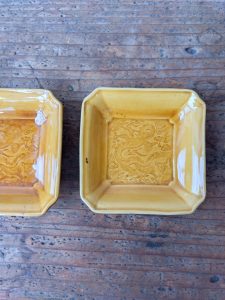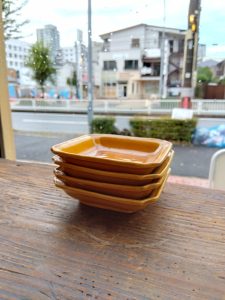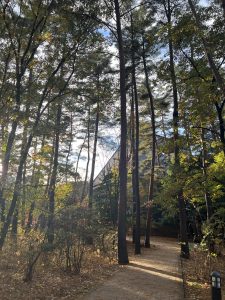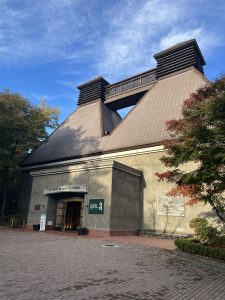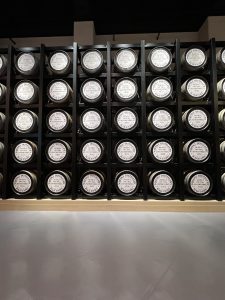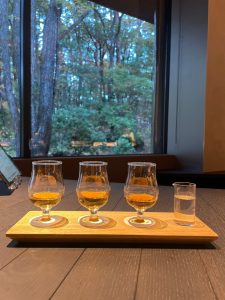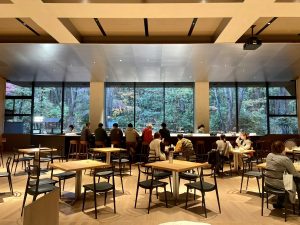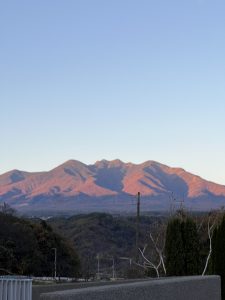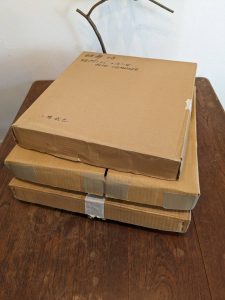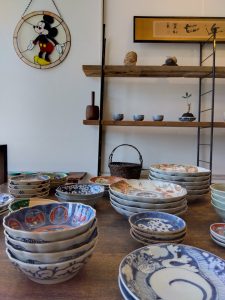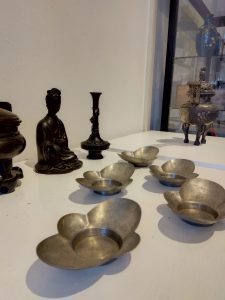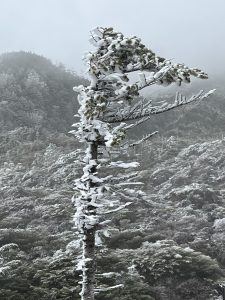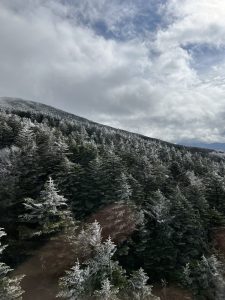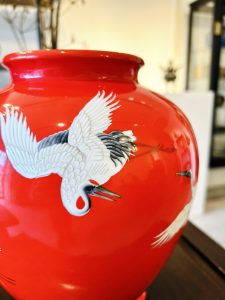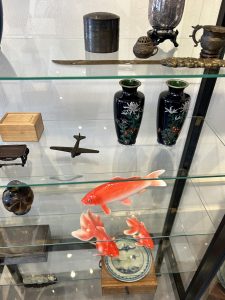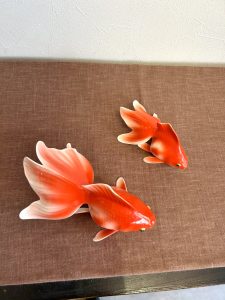みなさまこんにちは、スタッフYでございます。
八ヶ岳旅の続編の最終編、今回はいつも気になってました茅野市尖石縄文考古館へ行って参りました。
なぜもっと早くいかなかったのか、館内は国宝パーティでして、その展示数や縄文土器のその多種多様さに驚きでありました。

この辺り一帯の八ヶ岳西山麓の尖石遺跡からは縄文時代中期の遺跡でして、昭和5年から宮坂英弌氏によって発掘調査がされておりましたが、その後宮坂氏の研究内容により学術上の価値が高いとのことで、昭和27年に特別史跡に指定されております。
また、近隣の棚畑遺跡では、米沢(よねざわ)埴原田(はいばらだ)の工業団地の造成に伴い、昭和61年に発掘開始された市内でも最大規模の遺跡ですが、その遺跡からは縄文時代の前期から江戸時代までの生活の跡が見つかっています。
特に今から約4000年から5000年前といわれる縄文時代中期と呼ばれる時代の土偶をはじめ、膨大な量の優れた資料が出土しました。また、発見された住居址は150軒以上、完全に復元された縄文土器は600点。
縄文時代の集落は何軒かの家がお祭りなどに使う広場を中心にして環状に作られているのですが、ここから昭和61年(1986年)9月8日、国宝「土偶」(縄文のビーナス)が発見され、平成7年(1995年)6月15日国宝に指定されております。

国宝「土偶」(縄文のビーナス)
土偶はその広場の中の土坑と呼ばれる小さな穴の中に横たわるように埋められていたようです。博物館では、その埋められた当時のリアルな現場も再現されております。
全体像は下方に重心がある安定した立像形で、高さは27センチメートル、重さは2.14キログラム。
頭は頂部が平らに作られ、円形の渦巻き文が見られることから、帽子を被っている姿とも髪型であるとも言われています。文様はこの頭部以外には見られません。顔はハート形のお面を被ったような形をしており、切れ長のつり上がった目や、尖った鼻に針で刺したような小さな穴、小さなおちょぼ口などは、八ヶ岳山麓の縄文時代中期の土偶に特有の顔のようです。耳にはイヤリングをつけたかと思われる小さな穴があけられていますので、ちょっとかわいい。
腕は左右に広げられて手などは省略されており、胸は小さくつまみ出されたようにつけられているだけですが、その下に続くお腹とお尻は大きく張り出しており、妊娠した女性の様子をよく表していますね。
全体のつくりは、主な骨格となる部分を組み立てて、それに幾つかの粘土塊を肉付けするように丁寧に作られており、表面はよく磨かれて光沢があります。また、粘土は雲母が混じっており金色に輝いています。
焼きは一部甘いところがあり、右足には表面がはがれ落ちていたか所がありました。けれども、一般に見られる壊された土偶とは異なり、完全な形で埋められたものであることは明らか。
よって、八ヶ岳山麓の土偶の特徴と造形美を合わせ持つことや、当時の精神文化を考えるためにも貴重な学術資料であることから、平成7年(1995年)6月15日に縄文時代の遺跡から見つかったもののなかではじめて国宝に指定されました。名前も「縄文のビーナス」なんて素敵な名前がついております。
また、もう一つの女神。
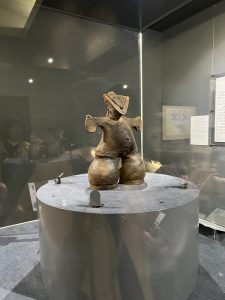
こちらは、国宝「土偶」(仮面の女神)
平成12年(2000年)8月23日に発掘され、平成26年(2014年)8月21日に国宝に指定されておりますから、つい最近のことなんですね。
「仮面の女神」の愛称をもつこの土偶は、茅野市湖東(こひがし)の中ッ原遺跡から出土した全身がほぼ完存する大形土偶です。高さは34センチメートル、重さは2.7キログラム。顔に仮面をつけた姿を思わせる形であることから、一般に仮面土偶と呼ばれるタイプの土偶というようです。今から約4000年前の縄文時代後期前半に作られました。
遺跡のほぼ中央にあるお墓と考えられる穴が密集する場所で、穴の中に横たわるように埋められた状態で出土したようでして、こちらも発掘の現場が再現されております。横たわっている姿はちょっと笑えます。
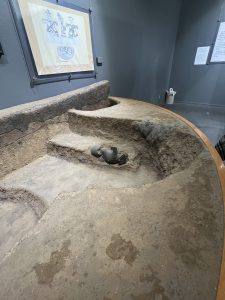
右足が壊れて胴体から外れていましたが、これはなぜか人為的に取り外したことが明らかになりました。お墓に一緒に埋納されたものか、あるいはこの土偶だけが単独で埋められたものかは、今後の研究を待たねばならないようです。
また、「仮面の女神」の顔面は逆三角形の仮面がつけられた表現になっており、細い粘土紐でV字形に描かれているのは、眉毛を表現しているのでしょうか。その下には鼻の穴や口が小さな穴で表現されております。体には渦巻きや同心円、たすきを掛けたような文様が描かれ、足には文様はなくよく磨かれています。
この土偶は、土器と同じように粘土紐を積み上げて作っているため、中が空洞になっており、こうした土偶は中空土偶と呼ばれ、大形の土偶によく見られる形態のようですね。
中ッ原遺跡の「仮面の女神」と似た土偶は、長野県辰野町新町遺跡や山梨県韮崎市後田遺跡で出土しており、どちらも20センチメートルほどの大きさであることを考えると、この土偶がいかに大きいかがわかります。
他にも、こちらの地域で発見された住居址は150軒以上、完全に復元された縄文土器は600点にもなりますので、展示の数も凄い。
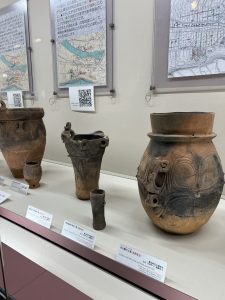
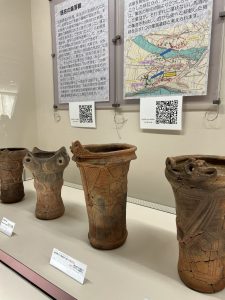
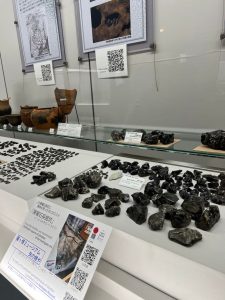
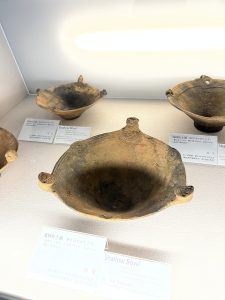
国宝パーティでした笑。
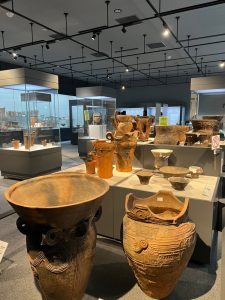
展示数は圧巻。ですが、同じものなどひとつもないです。
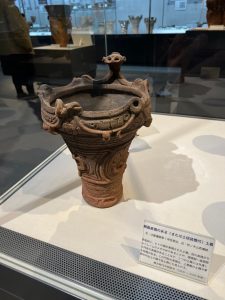
こちらは、イメージ通りの縄文土器でしょうか。
発掘されてた縄文土器ですが、装飾も焼き付けもそれぞれ違っており、丁寧に緻密に装飾しているものもあれば、大胆な新進気鋭の作家風もあり、もちろんへたくそな土器も発見されております。
それぞれの作者の性格や腕前の違いがよくわかりまして、縄文人とはいえひとくくりには言えないほどの多様性。
そして、なによりも縄文人もこうやって暮らしがあり、生活があり、こうやって我々の暮らしや命はつながってきたのなと5000年を一足飛びしてより一層身近に感じ取れる面白いひと時でありました。
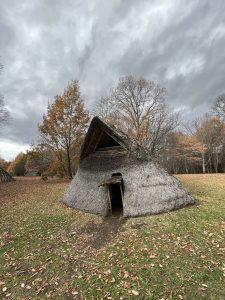
縄文時代にトリップしてみたい方はここははずせない博物館ですので、是非訪れてみてください。
それでは、ごきげんよう。
Hello everyone, this is Staff Y.
This is the final part of the Yatsugatake trip sequel, and this time we went to the Chino City Tsimiseki Jomon Archaeology Museum, which we have always been curious about.
Why didn’t we go earlier? The museum is a party of national treasures, and we were amazed at the number of exhibits and the variety of Jomon pottery.
The Senkishi ruins at the western foot of Mt. Yatsugatake were excavated in the middle Jomon period by Miyasaka Hideyoshi in 1930, and were designated as a special historic site in 1952 because of their high academic value.
The Tanahata Ruins, the largest ruins in the city, were excavated in 1986 in conjunction with the construction of an industrial park in Haniwarada, Yonezawa, and traces of life from the early Jomon Period to the Edo Period were found there.
In particular, an enormous amount of excellent materials have been excavated, including clay figurines from the Middle Jomon Period, which is said to be approximately 4,000 to 5,000 years ago. In addition, more than 150 dwelling sites have been discovered, and 600 pieces of Jomon earthenware have been fully reconstructed.
The Jomon period village was built in a circle around a square where several houses were used for festivals, etc. Here, on September 8, 1986, the national treasure “Clay Figure” (Jomon Venus) was discovered, and was designated a national treasure on June 15, 1995.
National Treasure “Clay Figure” (Jomon Venus)
The clay figurine seems to have been buried lying in a small hole, called a clay pit, in that square. The museum also reconstructs the realistic scene of the burial.
The entire statue is a stable standing figure with a lower center of gravity, 27 cm high and weighing 2.14 kg.
The head is flattened at the top and has a circular spiral pattern. No other patterns can be seen except on this head. The face is shaped as if wearing a heart-shaped mask, with slanted, upturned eyes, a pointed nose with a small hole as if pierced by a needle, and a small mouth like a small butterfly, which are typical of clay figurines from the middle Jomon period at the foot of Mt. The ears are pierced with small holes as if they were earrings, which is a little cute.
The arms are spread out to the left and right, omitting the hands, etc., and the breasts are only attached as if pinched out, but the belly and buttocks that continue below them protrude greatly, which well represent the appearance of a pregnant woman.
The entire piece was carefully constructed by assembling the main skeleton and then adding several lumps of clay to it, and the surface is well polished and shiny. The surface is well polished and shiny, and the clay has a golden color with mica mixed in.
Some of the firing was lax, and the surface of the right foot had peeled off. However, it is clear that the clay figurine was buried in perfect condition, unlike the broken clay figurines that are commonly seen.
Therefore, because it has the characteristics and beauty of the clay figurines found at the foot of Mt. Yatsugatake, and because it is a valuable academic material for considering the spiritual culture of the time, it was designated as a national treasure on June 15, 1995, for the first time among those found at a Jomon-era site. It also has a wonderful name, “Venus of Jomon”.
Another goddess.
This is the National Treasure “Clay Figure” (Masked Goddess).
It was excavated on August 23, 2000 (Heisei 12) and designated as a national treasure on August 21, 2014 (Heisei 26), so it was only recently.
This clay figurine, nicknamed “Masked Goddess,” is a large clay figurine with almost its entire body excavated from the Nakadahara Site in Kohigashi, Chino City. It is 34 cm tall and weighs 2.7 kg. It is a type of clay figurine generally called “masked clay figurine” because of its shape, which reminds us of a figure with a mask on its face. It was made in the first half of the late Jomon period, about 4,000 years ago.
It seems to have been unearthed in a state in which it was buried lying down in a hole in the middle of the site, where there is a cluster of holes that are thought to be graves. The figure lying down is a bit funny.
The right leg was broken and detached from the body, but it is clear that it was removed artificially for some reason. Whether it was buried together in a grave or only this clay figurine was buried alone seems to be a question that must await further research.
The face of the “Masked Goddess” is represented with an inverted triangular mask, and the V-shape drawn with thin clay strings may represent eyebrows. Below that, the nostrils and mouth are represented by small holes. The body is painted with whorls, concentric circles, and a tasuki (sashi-hanging) pattern, and the feet are well polished with no patterns.
Since these clay figurines were made by piling up clay strings in the same way as earthenware vessels, they are hollow inside, and such clay figurines are called hollow clay figurines, a form often seen in large clay figurines.
Clay figures similar to the “Masked Goddess” from the Nakagbara Site have been excavated at the Tatsuno-cho Shinmachi Site in Nagano Prefecture and the Goda Site in Nirasaki City, Yamanashi Prefecture, and both are about 20 cm in size, which shows how large this clay figure is.
There are also more than 150 other dwelling sites found in this area and 600 pieces of fully restored Jomon earthenware, so the number of exhibits is amazing.
It was a national treasure party lol.
The number of exhibits is impressive. But no two are the same.
Is this Jomon earthenware as you can imagine?
Some are carefully and intricately decorated, others are bold and in the style of up-and-coming artists, and of course, there are earthenware pieces that were found to be terrible.
The diversity of the Jomon people is so great that it is difficult to lump them all together.
It was an interesting moment for me to realize that this is how the Jomon people lived, and that our lives and livelihoods were connected in this way, jumping back 5000 years.
If you are interested in a trip back to the Jomon period, this is a museum you should not miss, so please visit.
Have a good day.
*******************
ご実家の整理やお片付けなどをされている方のご相談などが多くございます。
お片付けなどくれぐれもご無理のないようになさってくださいませ。
風光舎では古美術品や骨董品の他にも絵画や宝石、趣味のお品など様々なジャンルのものを買受しております。
お片付けをされていて、こういうものでもいいのかしらと迷われているものでも、どうぞお気軽にご相談下さいませ。
また風光舎は、出張買取も強化しております。ご近所はもちろん、愛知県内、岐阜県、三重県その他の県へも出張いたします。
まずは、お電話お待ちしております。
愛知県名古屋市千種区姫池通
骨董 買取【古美術 風光舎 名古屋店】
TEL052(734)8444
10:00-17:00 OPEN
#出張買取#骨董#古美術#骨董品#絵画#版画#茶道具#刀剣#彫刻
